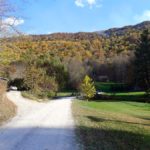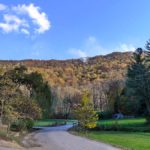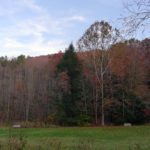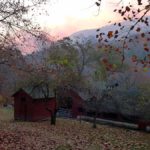Pine Mountain Settlement School
Series 11: Land Use
DANCING IN THE CABBAGE PATCH
Forests and Fires
DANCING IN THE CABBAGE PATCH Forests and Fires

Forest fires along the Little Shepherd Trail above Pine Mountain School. Oct. 29, 2016. High-tunnels for crops in the foreground. [p1130242]
NEWSPAPER ACCOUNTS
In 1922 an article appeared in the Harlan Daily Enterprise.
PlNE MOUNTAIN LADS LOSE TIME FROM SCHOOL WORK AND SLEEP.
REPORT OF FOREST FIRE IN VICINITY OF PINE MOUNTAIN SETTLEMENT SCHOOL
The total burned area of the last forest fire on Pine Mountain is 4000 acres. The cost $12,000. (a very conservative estimate). Cost includes:
- The destruction of half of the young trees forming the future forest crop.
- The injury to the soil such as burning of leaves, humus [sic] and ground cover.
- The injury to the standing timber by eating away the lower part of tree trunks until the wind blows the tree over or permits the entrance of wood-destroying fungi.
(signed) Leon F. Deschamps, Forester for the Pine Mountain Settlement School.
On November 28, 1922, the mountains around Pine Mountain Settlement School caught fire and threatened the entire community. As reported in the Pineville (Ky.) Sun the terrible fire created a serious re-assessment of the forests and the threat of fire to part of the School’s important resources. 10 students at Pine Mountain, led by Leon Deschamps, the school forester and also the leader of the local Boy Scout troupe put forward a petition which they hoped to forward to Kentucky’s Governor Morrow. The petition was also signed by 19 girls, members of the local Girl Scouts and supplemented by a letter from their Scout Captain, Miss Lucretia Garfield, grand-daughter of President Garfield, who was on the staff of the School as a teacher and Scout leader from 1919 to 1922. The petitioners asked that the Governor establish a forestry service and a state forester to be appointed to Harlan County. As part of the petition each of the boys who fought the fire, for an estimated 30 hours each, wrote of their personal experience fighting the fire in individual letters attached to the petition.

Mountain Day. Fire Tower in Kentenia State Forest. c. 1953 (Putney Tower). No fire towers were available until after 1937-38. Today the tower no longer exists.
The student letters were prefaced by one from Lucretia Garfield, Scout Leader. She describes the fire:
From October 27 to October 31, 1922 Pine Mountain Settlement school was surrounded by forest fires. There were fires along Pine Mountain for many miles on either side of the School, fires down Greasy Creek below the Medical Settlement and fires between the School and Line Fork Settlement seven miles to the east,
For a week the boys of Pine Mountain School had been fighting fires in the mountain now and then, but from October 28 to 31 they fought night and day. The dry woods burned fast and the fires were coming down the mountain toward the School. For hours the boys worked to rake large rings about each fire and then started back-fires to make the rings wider. Several times the fire broke over the rings and just as the boys were ready to come in at night another alarm was called. They say that one man near Nolansburg let out the fire that spread up Pine Mountain and westward along the top of the mountain, past the Dillon Trail, past Divide, and far down toward Incline.
The Line Fork fire which spread up Bear Creek burning on both sides for many miles was said to have been started by one boy who lit a brush pile for fun.
Her letter is followed by a summary of the time lost from school, work, and sleep by the boys of the Pine Mountain school, while they were fighting the forest fires.
The following is a summary of the time lost from school, work, and sleep by the boys of the Pine Mountain Settlement School while fighting these forest fires:
Average time spent by each boy fighting fires: 30 hours
Average time lost from school: 1-2 hours
Average time lost from work: 14 hours
Maximum time spent in fighting fires by any boy from October 27 to 31, 1922: 40 hours
But the best story of the fight the children made is told by them, in their own way. Some of them have made written report of their part in the fight, as a requirement in their school work, and their story, brief, simple, but convincing, tells the story of the seriousness and danger better than any other version could tell, and a few of those compositions follow.
By Clarence Dozier ; Grade VII: November 3, 1922.
Sunday morning there was a fire on top of the Pine Mountain. Mr. Deschamps who is the Boy Scouts Master took ten or twelve Boy Scouts to fight fire. We took our dinner and stayed there until 6 o’clock Sunday night. We came off the mountain and ate our supper, the five boys went back to make a fire-line around the fire. They stayed until midnight. The next morning when they got there the fire had broken over and was coming over into the school ground. One of the boys came back to tell Mr. Deschamps about the fire. Before he got down the mountain he met Mr. Deschamps with some of the boys. They fought fire until dinner. Then some of us went back and made a fire-line from the top of the mountain down to the Lime Stone Cliffs. After we got through with the line we went back to the top of the mountain. And three of the boys went over the fire line. One of them came back where the boys were waiting for him and he said, “boys the fire has broken over the line.
We went to the fire and raked as much as we could. After a while a man came to help us fight the fire.
I fought fire 40 hours. Time lost from school, three days. Time lost from work, three days. Hours lost from sleep, five.
STUDENT REFLECTIONS
Discovering a Fire
By Roy Redwin, Grade VII; November 3, 1922.
One morning when I was working for Miss Pettit who is my house mother, we noticed the smoke rising up behind Pine Mountain. Mr. Deschamps who looks after the forest at Pine Mountain, took me with two other boys to the top of the mountain to investigate the smoke. He climbed a tree to see if he could see fire. When he got down he said that he could “see fire i the distance.” Then we went on out a piece farther ad burnt a fire line so that if the fire came dow there it could not get over into the school grounds. We stayed all night and next morning we came back about 7:30 o’clock smoke was rising very fast ad some boys went up to try to put it out. This was the beginning of a forest fire which lasted about seven days. I spent about twenty-six hours fighting fire. I lost about seven hours fro school. I lost about eighteen hours of work time. The fire has destroyed many fine trees ad killed many young ones.
How I Fought Fire
By Watson Caudill, Grade VI; November 3, 1922.
Last Sunday with some other boys I went to fight fire on the Pine Mountain, on top of the mountain, where the Nolansburg trail crosses. We started raking a fire-line on top of the mountain down towards Nolansburg. We went half way down the mountain ad burnt it so that it would not catch over. When we had burnt it off we came back to the top of the mountain and it had caught over this side. We worked about two hours more before we got it stopped. And then we came to the house and went to bed at one o’clock that night. The next morning it had caught over again and we had to take up the fight again. I missed school two days and sleep two nights. I fought fire about 22 hours in all.
By Harry Callahan, Grade VII; November 3, 1922
One afternoon Mr. Deschamps who is the Boy Scout Master at Pine Mountain Settlement school came in and said he wanted some one to go and fight fire with him. He just took three boys at first, and after a while he came back after some more boys to help him. He just took three boys at first, and after a while he came back after some more boys to help him. He said that the flames were crossing the line ad that evening some of the Boy Scouts went and stayed out all night fighting fire.
The next day was Sunday and just as soon as the boys got back they saw that it was across the fire-line and they had to go back and fight all day Sunday. When Mr. Deschamps came in that night he asked for volunteers to go and stay out that night and fight fire.
One night we ate supper and went back and fought fire till about 10 o’clock that night. All the time we fought fire amounted to about six days of hard fighting.
By Gardner Combs, Grade VI; November 3, 1922.
Sunday a fire broke out in the forest and the boys at Pine Mountain were asked to help put it out. One party of boys went Sunday and another at night.
The fire was coming up the other side of the mountain when we got there, and we began to rake a fire-line around the fire. When the ring was all way around the fire, we set fire to the leaves, next to the ring, to meet the fire coming. Then we came home at one o’clock in the night.
The next day the fire broke over the time [sic line] and most all the boys went out to put it out. We raked a ring all the way around the fire, but it broke over again. Then we all went up and raked another ring and this time we put it out. I worked about thirty-four hours in all. I lost about 13 hours from school. I lost about 14 hours of work. I lost about six hours of sleep.
NEWSPAPER ARTICLE
- Harlan Daily Enterprise, 1922. PlNE MOUNTAIN LADS LOSE TIME FROM SCHOOL WORK AND SLEEP.
- Harlan Daily Enterprise, 1922. PlNE MOUNTAIN LADS LOSE TIME FROM SCHOOL WORK AND SLEEP.

Forest fires above the Chapel, Pine Mountain, KY. Oct. 30, 2016.
HARLAN COUNTY FIRST COUNTY IN STATE TO CREATE FOREST FIRE PROTECTIVE ASSOCIATION
According to historian George E. Thompson, in his 2009 publication, You Live Where?, Harlan County, in 1913, was the first county in the state to create a forest fire protective association. The first state forest in Kentucky was also created in Harlan County in 1919, the Kentenia State Forest.
By 1925 the President of the United States had issued a Proclamation that declared April 27- May 3rd to be “American Forestry Week”. He stated that “I desire to bring to the attention of all our people the danger that comes from the neglect of our forests.” His proclamation was an enlargement of the “Forest Protection Week” that had been in place for several years. It was clear that all was not right with American forests in the 1920’s, what Coolidge called “unwise dissipation of a great resource.”
AMERICAN FORESTRY WEEK
- American Forestry Week Proclamation of Calvin Coolidge. 1925
- Kentucky Dept. of Agriculture support of the Coolidge American Forestry Week, 1925.
BLANTON FOREST
Even in these early years the people of Harlan County recognized and wanted to protect their forests. One of those Harlan County natives, Grover Cleveland Blanton, a grocer from Wallins Creek, near Harlan, had a particular love of forests and continued to purchase forest land to add to the Blanton forest all his life.
Grover Blanton was particularly fond of one tract that showed no signs of logging or removal of trees. It was that particular tract that became a focus of energy for conservationists. Just four miles west of the town of Harlan, that tract, later Blanton forest, is literally a national treasure. It is one of the oldest forests in America that is designated “old-growth” forest. Many of the trees, some over 150 feet high and some four feet in diameter have weathered many fires over the centuries. And, there have been many centuries. Some estimate many of the trees of 25-30 different species, are 300 to 400 years old. Many show the scars of fire.
This large forest, the Blanton Forest, is comprised of 2,350 acres, of which 1,075, the least disturbed portion, has been set aside for a nature preserve. This important section is positioned on the south flank of the long Pine Mountain range that stretches through Harlan County, the longest of Kentucky’s counties (some 50 miles long by 20 miles wide). Marc Evans, working for the state Nature Preserves Commission to inventory the state’s forests, is credited with the “discovery” of this remarkable old-growth” forest. Marc is currently a Pine Mountain Settlement School board member. When he walked into the area in 1992 he was astounded by what he saw and began a campaign to recognize and preserve the forest. In 1995 working with the Nature Preserves Commission, and with William Martin, then the Natural Resources Commissioner, about half of the Blanton Forest was purchased for $750,000. This was the 1,075 acres identified as critical to preserving. The care given to this forest by the Blanton family and the care given to other forests in Eastern Kentucky, particularly Lilly Woods, and the forest in the Bad Branch area of Letcher County, are treasures that are very susceptible to fire.
The forest surrounding Pine Mountain joins a remarkable gathering of unique and irreplaceable forest lands in Eastern Kentucky. Since 1913, when the School was founded, there have been fires in the forests of the school like the one mentioned above. Most of them were the result of careless behaviors. William Martin, an expert in old-growth forests and former Natural Resources Commissioner for Kentucky in the early 1990’s, once remarked, “A tree doesn’t care how long a human being lives …” But, it is clear that we humans need to heighten our understanding of the life of trees. In many ways, they are our legacy. Today, along with fire, a recurring challenge to forests in Harlan County is irresponsible timbering. Grover Blanton made it clear throughout his lifetime that his forest was “More than timber.” “This is for saving,” he told his daughters, Nora and Serena Knuckles.
IRRESPONSIBLE TIMBERING
Today, along with fire, a recurring challenge to forests in Harlan County is irresponsible timbering. Grover Blanton made it clear throughout his lifetime that his forest was “More than timber.” “This is for saving,” he told his daughters, Nora and Serena Knuckles. They did that and continue to advocate for their father’s legacy.
The care given to this forest by the Blanton family and now the Nature Preserves Commission, and the care given to other forests in Eastern Kentucky, particularly Lilly Cornett Woods, and the forest of the Bad Branch area of Letcher County, near Pine Mountain School, cannot be underestimated. These two forest tracts are treasures that are susceptible to timbering and to fire but are in many ways they are less susceptible than new forests.
Many of the old-growth forests have a built-in fire protection. Many of them have large “boggs” and a moist understory that holds moisture when other forests have succumbed to long periods of drought. As we struggle with Global Warming that is intensifying, this feature of old-growth forests and well maintained forests will become increasingly important. The forests surrounding Pine Mountain are joining other unique and irreplaceable forest lands in Eastern Kentucky in monitoring care and preservation.
HUMAN BEHAVIOR AND FIRE BEHAVIOR
Fires in forests have been present throughout history. Since 1913, when the School was founded, the fires in the Pine Mountain Settlement School forest, have been recorded, and like those described above, and like many of the fires of today, most of the fires were a result of careless and often malevolent behaviors.
In 1995 two fourth grade classes at Wallins Elementery School received a $500 grant from the Kentucky Environmental Council to develop games, a study guide, and other activities to heighten awareness of the unique forest in their back-yard and to educate for preserving that legacy. Education has always been linked to responsible fire management.
Fortunately, fires in Eastern Kentucky are usually in the understory and not the fierce fires in the tree crowns seen in the Western United States. Yet, the contributing wind can quickly change that comparison. It only takes one fire such as the one recently seen in the Great Smoky Mountains at Gatlinburg to remind us of the danger of fires in the Appalachian mountains. When all the elements conspired a conflagration, can be as destructive as that seen in the Western United States. The following photograph in the Pine Mountain Settlement School Collections, taken in a very dry year in the early 1940s, shows a particularly fierce fire on the ridge-crest of the Pine Mountain, near the School.

Forest fire on the ridge-top of Pine Mountain, c. 1945
OCTOBER 2016 FIRE REFLECTIONS
In October 2016 the Pine Mountain was again on fire. A series of small fires deliberately set along the Little Shepherd Trail grew into large fires that crept down the mountain. Today no small boys were sent up to meet the growing danger, but the small staff watched warily as the forest cleared its under-story and discussions centered on the process of making ready for the seeds of Spring. Yet, with each increase in the wind the observers grew more anxious and small groups went into the forest to combat the flames as they steadily marched down the mountain toward buildings. Shortly a misting rain fell and everyone sighed relief yet many paused to consider and to wonder what it is in our common human community that still finds pleasure in setting things afire.
An editorial in the Lexington Herald, November 20, 1994 “Arsonists rob E. Kentucky of its verdant forests,” by Doug Crawford, wondered this, as well. He said, “…it is difficult to understand how one element of Eastern Kentucky’s own could be so disillusioned, so ostracized, so contemptuous that it could willfully destroy the region’s greatest and most lasting natural resource.” He goes on to muse that the
“... epidemic of arson fires would seem to be a symptom of something still larger, reflecting a mentality similar to those who thoughtlessly trash the roadways and countrysides of Eastern Kentucky ….the people who are doing this have no respect for themselves or where they come from …The motivations for such behavior one can only speculate. Revenge? Contempt? Power? Kicks? ….whatever the reasons, getting at the root of this self-destructiveness is growing more crucial to the survival of Eastern Kentucky.”

The Pine Mountain ridge in full Fall color. Late afternoon as fires begin to grow on South side of mountain.. October 28, 2016.
Pine Mountain Settlement School continues its environmental education work. The year-round Environmental Education program which began in 1972 is no longer a focus of programming but it sits in the center of both the school outreach and the adult programming of the institution. Programming continues to offer students from throughout the state and beyond, the opportunity to study forest ecology, biodiversity, stream ecology and other aspects of environmental education for short or week-long sessions for public and private schools. Environmental education offers hope for a way out of the cycle of insensitivity and senseless crime and despair. It is never too early or too late to learn and devise ways to cope with the environmental changes occurring around us.
[Contact Pine Mountain Settlement School for information on educational programs or visit https://www.pinemountainsettlementschool.com/ for a list of programs and workshops.]
GALLERY (Included 2016 fire)
- October 28, 2016 Smoke on mountain
- October 28, 2016 Fog and smoke.
- October 29, 2016 Smoke to east
- October 29, 2016 Smioke to west
- October 29, 2016 Smioke to west
- October 29, 2016 Smioke to west
- October 29, 2016 “Trunk or Treat” on campus.
- “Trick or Treat” on campus. Halloween fairy and father. ,October 29, 20016. [p1130209.jpg]
- “Trunk or Treat” on campus. Halloween Ghost Busters. October 29, 2016. [p1130258.jpg]
- October 29, 20016 Looking west.
- October 29, 20016 Looking west.
- October 29, 20016 Looking west.
- October 29, 20016 Looking west.
- October 30 20016 Toward Chapel
- October 30, 20016 View east from Barn.
- October 30, 2016 View of mountain behind Chapel
- October 30, 2016 View of mountain behind Chapel
- October 30, 2016 View of mountain behind Chapel
- October 31, 2016 Nest day view toward Chapel.
- October 31, 2016 View of mountain behind Chapel at sunrise.
- October 31, 2016 View of mountain behind Chapel
- Novermber 1, 2016 View of mountain behind Chapel
- Novermber 1, 2016 Playground looking east toward Totz across mountain
- November 2, 2016 View of mountain
- November 2, 2016 ew of mountain
- November 2, 2016 View of mountain toward west.
- November 2, 2016 Night view of mountain
- November 3, 2016 View east toward Cumberland. Morning
- November 3, 2016 View east toward Cumberland. Morning
- November 3, 2016 View east toward Cumberland. Morning
- November 3, 2016 View to mountain behind Laurel House
- November 3, 2016 View to mountain behind Laurel House
- November 3, 2016 Fire trucks arrive. It begins to rain.
GO TO:
DANCING IN THE CABBAGE PATCH – ABOUT
DANCING IN THE CABBAGE PATCH I – GUIDE






































